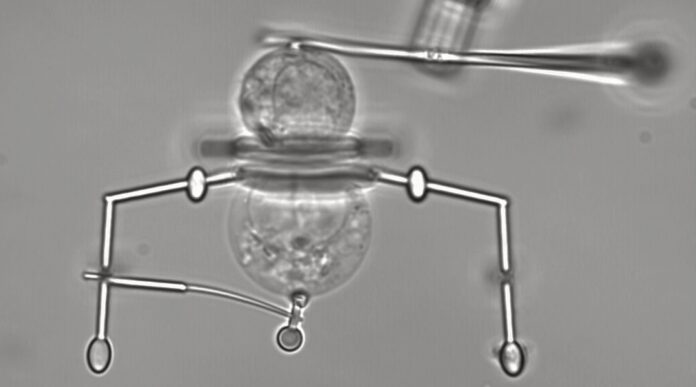Researchers have engineered a new set of laser-controlled micro-robots capable of handling individual cells—one of the fundamental units of life. These tiny devices, outfitted with nanoscale grippers, can grasp, move, and rotate cells that measure between 30 to 40 micrometers, opening fresh avenues for imaging and studying cellular interactions.
A Breakthrough in Microscopic Handling
Lóránd Kelemen, a biophysicist at the HUN-REN Biological Research Centre in Szeged, Hungary, collaborated with peers in Hungary and Slovakia to develop these innovative tools. They integrated their design with optical tweezers—a longstanding technique where focused laser beams trap microscopic objects. As a small object enters the beam’s focus, it refracts the light, which in turn alters the light’s momentum. This interaction produces a counterforce that holds the object in place.
Enhancing Optical Tweezers
Traditional optical tweezers, when used directly on cells, can inadvertently heat and damage delicate cellular structures. Moreover, the method struggles with stability and force because of the size discrepancy between the cell and the laser beam, compounded by the water medium in which the cell is suspended.
Previously, scientists tried attaching microbeads or other structures to cells to create handles for optical tweezers. However, these attachments often harmed the cells and could not be removed once applied—much like using adhesive tape to stick a cotton ball onto a spatula, which makes later removal destructive.
A Gentle Alternative
The newly developed micro-robots overcome these limitations. They are small and flexible enough to grip cells gently while also being compatible with the optical tweezer’s beam. Their design process involved another laser system using two-photon polymerization—a technique that hardens a polymer only where a tightly focused beam of light hits, allowing for precise fabrication at the nanometer scale.
Precision Engineering at Its Best
The challenge lay in designing tools that were thin and flexible enough to both grip cells and withstand the forces from the optical tweezers. Kelemen noted that even a slight change in the thickness of an elastic component (from 400 nm to 600 nm) could significantly affect its responsiveness to the laser beam. In experiments, the researchers demonstrated that the optical tweezers could deform part of the micro-robot to open it for cell capture. Once the cell is secured by the tool’s elasticity, the beam can then focus on a stiffer section of the device to move the cell—much like the gentle handling required to move a cotton ball with a spatula without damaging it.
Versatile Tools for Cellular Research
The team devised three distinct tools: one to transfer cells between locations, another to rotate cells for detailed microscopy, and a third to press two cells together to observe their interactions. Although the development process was long and filled with unexpected challenges, the final micro-robotic tools offer a non-invasive method to manipulate and image cells in their natural environment.
While optical tweezers remain a specialized instrument, Kelemen suggests that laboratories with access to the necessary equipment can adapt and optimize these microtools for various research tasks. With a blueprint now available and two-photon polymerization systems becoming more accessible, labs capable of affording such systems can potentially produce these structures and further refine their applications in cellular research.





